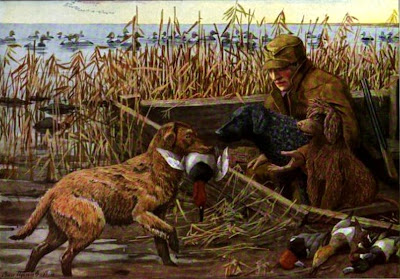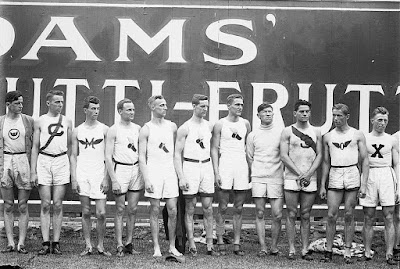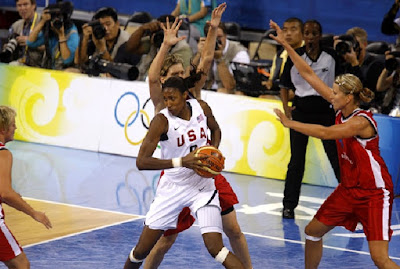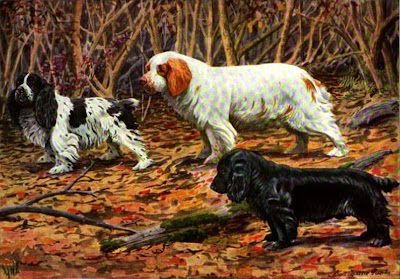 | Many breeds of dogs have been trained to find and bring in game which has been shot, but retrievers, as their name implies, are bred specially for that purpose. |
English sportsmen had for some time been experimenting with different breeds in an effort to find a dog exactly suited for retrieving game, when, about the middle of the last century, there was introduced from Labrador a hardy, black-coated, small-eared, medium-sized dog, which seemed to answer the purpose. He was a typical water dog and not subject to ear canker, which so often develops in spaniels used to retrieve waterfowl.
This Labrador dog, crossed probably with the English setter, and perhaps with other
breeds, produced the retriever, which may be either black or liver brown. In size about like a pointer, covered all over with a coat of tight, curly hair, Astrakhan-like, except for his smooth head and face, he is a curious-looking dog.
He is a capable and teachable creature, however, and makes a capital assistant in the duck-blind or as a gun-dog, where birds are the quarry. The curly retriever may be either coal black or dark liver brown. He should weigh about 65 to 80 pounds. There is also a smooth retriever, which is much like the curly in form and size, but has straight hair.
The Labrador retriever is shorter of leg than the other types and generally more solidly built. It is generally some shade of brown, and none of the retrievers should show more than a trace of white on the chest. All have smaller ears than the pointer or setter, and the curly type carries his close to the head. The original "Labrador,"' or something very like, still exists under the same name, as a distinct and recognized breed. He has all the good qualities of both of these highly intelligent parents.
CHESAPEAKE RETRIEVER - This is an essentially American dog and has come to a high state of perfection along the eastern seaboard, and, as an introduced type, is much esteemed in the ducking marshes of the Northwest. His parentage is supposed to be chiefly otterhound and Labrador, but it is altogether probable that other blood runs in his veins, as he is one of the dogs that has been developed for a particular use through particular qualities his ancestors were found in actual practice to possess.
The result is a very curious, very excellent, but not very stable nor beautiful dog. But no known dog is such an unswervable retriever or can stand a fraction of the exposure to icy wind and icy water which this hardy fowling dog seems to revel in. To meet this rigorous demand, he has a curious, deep woolly undercoat that seems never to wet through, such as we find on water-dwelling mammals like the otter; this is protected and covered by a harsh, strong coat of regular hair, straight or slightly curly, from which one good shake drives practically all the water.
They will chase a wounded duck over or under the ice and will follow the liveliest "cripple" till it wearies. In open deep-water duck hunting such a dog is invaluable. They vary from 60 to So pounds in weight and from 22 to 25 inches in height. The ear is quite short and set rather high, giving a squarer look to the head than in the setter, which it remotely resembles. They are tawny brown or "sedge color" generally, though other less desirable colors are met with occasionally.
THE IRISH WATER SPANIEL - Identified more or less with the retrievers, because they perform similar duties, are the sporting spaniels, which, because they arc divided into so many branches, constitute perhaps the largest dog family in the world.
The English "Kennel Club" recognizes Irish water spaniels, water spaniels other than Irish, Clumber spaniels, Sussex spaniels, field spaniels. English springers, Welsh springers, and cocker spaniels. They are all used to assist the gunner to find his game and to retrieve it after it is shot.
The Irish water spaniel is in a class by himself. You need to see him but once to remember him forever. It is said that he was the very last dog to be made and that it was only by using the remnants of half a dozen other breeds that enough material was found of which to make him.
When he comes up to you for the first time, you'll probably laugh at him ; but don't laugh too long ; there'll be tears in your eyes if you do. For this quaint creature who looks as if he had borrowed from friends everything he has on, including his tail, has such an honest face, such a charming expression, and such a dignity of manner that he'll win your sympathy and your respect before the first smile of
amusement has left your face.
As a water dog, he is generally regarded as superior to any other member of his family, though most spaniels take kindly to the water. Formerly quite a popularly known dog for sniping and ducking, the old Irish water spaniel seems to have been almost entirely abandoned, and few are now seen in this country. Perhaps the uses to which he was put are more satisfactorily met by the setters and retrievers, both of which are stronger and heavier and can equal him in work in the water.
The type of this breed should weigh about 50 pounds and be of a uniform liver-color.
The coat is quite long and tightly curled, but by no means woolly. It is long on the crown, but the face, front of hind legs, and most of the tail should be clothed in short, soft, rather dull hair, giving the appearance of having been clipped.
It is very different in appearance from the land spaniel of the cocker type, being in shape and size not greatly unlike the poodle, but differing much from this breed in texture of coat and in the perfectly smooth face. In disposition it is like both the poodle and the spaniels generally — kind, affectionate, playful, and bright, but showing a strong tendency to be a little aloof with strangers.
They have also a strong trend toward obesity in age, when they become heavy, untidy, and decrepit.
From The Book of Dogs: An Intimate Study of Mankind's Best Friend By National Geographic Society (U.S.), Louis Agassiz Fuertes, Ernest Harold Baynes Published 1919. 109 pages Original from Harvard University.
This image (or other media file) is in the public domain because its copyright has expired.
This applies to the United States, where Works published prior to 1978 were copyright protected for a maximum of 75 years.
See
Circular 1 "COPYRIGHT BASICS" from the U.S. Copyright Office. Works published before 1923 are now in the public domain In the United States,
This inage is also in the public domain in countries that figure copyright from the date of death of the artist (post mortem auctoris in thi case Louis Agassiz Fuertes (1874 – 1927) and that most commonly runs for a period of 50 to 70 years from that date. If your use will be outside the United States please
check your local law.
Tags:
Public Domain Clip Art and
clip art or
public domain and
Labrador Retriever or
Irish water spaniel































